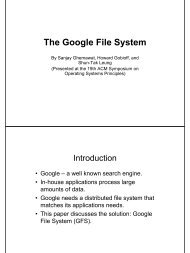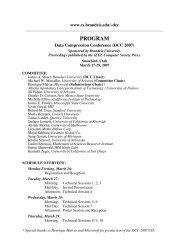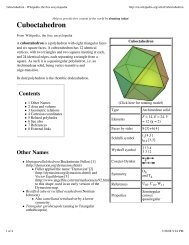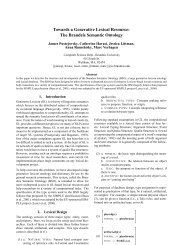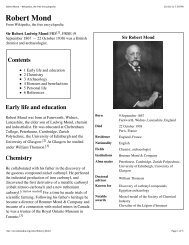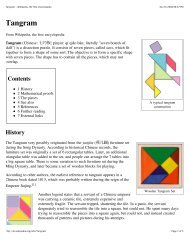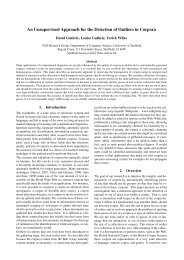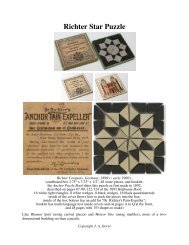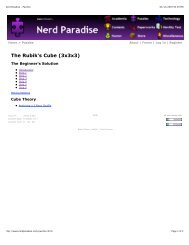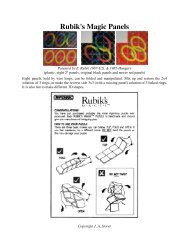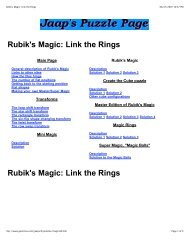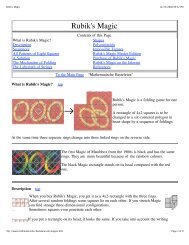A Hebrew Tree Bank Based on Cantillation Marks
A Hebrew Tree Bank Based on Cantillation Marks
A Hebrew Tree Bank Based on Cantillation Marks
You also want an ePaper? Increase the reach of your titles
YUMPU automatically turns print PDFs into web optimized ePapers that Google loves.
A <str<strong>on</strong>g>Hebrew</str<strong>on</strong>g> <str<strong>on</strong>g>Tree</str<strong>on</strong>g> <str<strong>on</strong>g>Bank</str<strong>on</strong>g><br />
<str<strong>on</strong>g>Based</str<strong>on</strong>g> <strong>on</strong> Cantillati<strong>on</strong> <strong>Marks</strong><br />
Andi Wu<br />
GrapeCity Inc.<br />
andi.wu@grapecity.com<br />
Kirk Lowery<br />
Westminster <str<strong>on</strong>g>Hebrew</str<strong>on</strong>g> Institute<br />
klowery@whi.wts.edu<br />
Abstract<br />
In the Masoretic text of the <str<strong>on</strong>g>Hebrew</str<strong>on</strong>g> Bible (HB), the cantillati<strong>on</strong> marks functi<strong>on</strong> like a punctuati<strong>on</strong> system that shows the divisi<strong>on</strong> and<br />
subdivisi<strong>on</strong> of each verse, forming a tree structure which is similar to the prosodic tree in modern linguistics. However, in the<br />
Masoretic text, the structure is hidden in a complicated set of diacritic symbols and the rich informati<strong>on</strong> is accessible <strong>on</strong>ly to a few<br />
trained scholars. In order to make the structural informati<strong>on</strong> available to the general public and to automatic processing by the<br />
computer, we built a tree bank where the hierarchical structure of each HB verse is explicitly represented in XML format. We coded<br />
the punctuati<strong>on</strong> system in a c<strong>on</strong>text-tree grammar which was then used by a CYK parser to automatically generate trees for the whole<br />
HB. The results show that (1) the CFG correctly encoded the annotati<strong>on</strong> rules and (2) the annotati<strong>on</strong> d<strong>on</strong>e by the Masoretes is highly<br />
c<strong>on</strong>sistent.<br />
1. Introducti<strong>on</strong><br />
Linguistic annotati<strong>on</strong> of written texts has been <strong>on</strong>e of<br />
the main efforts of language resource development in<br />
recent years, due to the availability of electr<strong>on</strong>ic texts in<br />
large quantities and the advancement of NLP technologies.<br />
However, text annotati<strong>on</strong> is not a modern inventi<strong>on</strong>. It<br />
dates back at least to the 9 th century when a group of<br />
Jewish scholars, called the Masoretes, annotated the text<br />
of the <str<strong>on</strong>g>Hebrew</str<strong>on</strong>g> Bible (HB). One of the annotati<strong>on</strong> tasks<br />
they undertook was to punctuate the text in a systematic<br />
way so that the verses may be read or chanted with the<br />
correct int<strong>on</strong>ati<strong>on</strong>al oral units. In the eyes of a modern<br />
linguist, the punctuati<strong>on</strong> represents a hierarchical<br />
bracketing of each verse, marking a structure that<br />
resembles the prosodic structure (Selkirk 1984) of the<br />
verse.<br />
The punctuati<strong>on</strong> system c<strong>on</strong>sists of a set of cantillati<strong>on</strong><br />
marks 1 . There are three uses of the cantillati<strong>on</strong>: syntax<br />
(text segmentati<strong>on</strong>), ph<strong>on</strong>ology (where the accent occurs),<br />
and music (melodies). Unlike modern punctuati<strong>on</strong> marks<br />
that are independent characters, the cantillati<strong>on</strong> marks are<br />
small diacritics added to the c<strong>on</strong>s<strong>on</strong>ant characters of the<br />
text, which makes them hard to identify. Besides, the<br />
marking system is so complicated with such a variety of<br />
symbols that <strong>on</strong>ly a few trained scholars know how to use<br />
it. As a result, the rich structural informati<strong>on</strong> has<br />
remained hidden for most of the c<strong>on</strong>temporary readers.<br />
In order to make the informati<strong>on</strong> accessible to<br />
comm<strong>on</strong> readers for better understanding of HB and to the<br />
computer for automatic processing, we researched this<br />
punctuati<strong>on</strong> system to work out the rules underlying the<br />
annotati<strong>on</strong>, coded the rules in a c<strong>on</strong>text-free grammar, and<br />
parsed the whole HB with this CFG. The result is a<br />
1 The cantillati<strong>on</strong> marks show how a text is to be sung. See<br />
http://en.wikipedia.org/wiki/Cantillati<strong>on</strong>. They are also called<br />
“accents”. For c<strong>on</strong>sistency of terminology, we will always call<br />
them “cantillati<strong>on</strong> marks” or just “marks”.<br />
1246<br />
prosodic tree bank of HB where the structure of each<br />
verse is represented in a format that is familiar to modern<br />
linguists. The tree bank can be used to view the structures<br />
of the verses or as a basis for developing a syntactic tree<br />
bank of BH.<br />
2. The Cantillati<strong>on</strong> System<br />
2.1. Types of cantillati<strong>on</strong> marks<br />
There are two types of cantillati<strong>on</strong> marks: c<strong>on</strong>junctive<br />
marks and disjunctive marks. They serve different<br />
functi<strong>on</strong>s but are both structurally significant.<br />
C<strong>on</strong>junctive marks group two or more<br />
words/morphemes into a single unit. When a word 2 bears<br />
a c<strong>on</strong>junctive mark, it is supposed to be pr<strong>on</strong>ounced<br />
“together with” the following word, with no break<br />
between the two. There are several different diacritic<br />
symbols of c<strong>on</strong>junctive marks, but their functi<strong>on</strong>s are<br />
similar.<br />
In the text we use, which is from Groves & Lowery<br />
(2006), some words do not carry any cantillati<strong>on</strong> marks.<br />
They were not independent words in the original<br />
Maroretic text and became words <strong>on</strong>ly after further<br />
segmentati<strong>on</strong> in more recent analysis. These words are<br />
always grouped with the word that immediately follows it,<br />
as if it carried a c<strong>on</strong>junctive mark. We will c<strong>on</strong>sider those<br />
words as having a zero (invisible) c<strong>on</strong>junctive mark. This<br />
way every word in the verse will have a cantillati<strong>on</strong> mark.<br />
The disjunctive marks, <strong>on</strong> the other hand, are much<br />
more complicated. They divide and sub-divide a verse<br />
into successively smaller units until a single word or a unit<br />
2 The distincti<strong>on</strong> between words and morphemes is fuzzy in<br />
<str<strong>on</strong>g>Hebrew</str<strong>on</strong>g>. Many segments are words syntactically but are<br />
traditi<strong>on</strong>ally treated as morphemes simply because they are not<br />
independent ph<strong>on</strong>ologically. In this paper, we will use “word”<br />
to refer to any syntactically independent unit regardless of its<br />
ph<strong>on</strong>ological status.
formed by c<strong>on</strong>junctive marks is reached. The structure<br />
formed by this divisi<strong>on</strong> is hierarchical and more much<br />
interesting syntactically.<br />
2.2. Hierarchy of disjunctive marks<br />
The disjunctive marks can be classified into different<br />
ranks according to their dividing power. The mark of the<br />
highest rank (Rank-1) is Soph Pasuq which divides<br />
between verses and can be c<strong>on</strong>sidered the root node of a<br />
verse. The Rank-2 marks (such as Athnach) divide a verse<br />
into two halves, with the major break of the verse<br />
occurring right after the word bearing the mark. Each of<br />
the two parts can then be sub-divided by Rank-3 marks.<br />
There are also Rank-4 and Rank-5 disjunctive marks that<br />
further divide the segments resulting from the divisi<strong>on</strong> of<br />
a higher-rank mark.<br />
Take Genesis 1:3 as an example. If we use English<br />
words instead of <str<strong>on</strong>g>Hebrew</str<strong>on</strong>g> words, use hyphen to stand for<br />
c<strong>on</strong>junctive marks, and use diacritic numbers to stand for<br />
disjunctive marks of different ranks, the verse will look<br />
like this 3 :<br />
and- said- God 3 be- light 2 2 1<br />
and- was- light<br />
We can see that the last word has two marks, the<br />
Rank-1 mark (Soph Pasuq) indicating the end of a verse<br />
and a Rank-2 mark indicating the end of the sec<strong>on</strong>d half of<br />
the verse. We can also see the primary break of this verse<br />
is after the first “light”. The sec<strong>on</strong>dary break is after<br />
“God”. The units formed by the c<strong>on</strong>junctive marks are<br />
“and said God”, “let be light” and “and was light”. The<br />
equivalent bracketing of this verse is:<br />
[ [ [ and said God] [ be light ] ] [ and was light ] ]<br />
As we can see, the structure represented by the<br />
cantillati<strong>on</strong> marks provides valuable informati<strong>on</strong> for the<br />
correct reading of this verse. Without the cantillati<strong>on</strong><br />
marks, there is nothing there to prevent us from getting the<br />
following wr<strong>on</strong>g analysis where “let there be light” and<br />
“there was light” are c<strong>on</strong>joined to serve as the object of<br />
“God said”:<br />
[ [ [ and said God] [ [ be light ] [ and was light ] ] ]<br />
Although <str<strong>on</strong>g>Hebrew</str<strong>on</strong>g> reads right-to-left, the computer will<br />
read left-to-right. Besides, the left-to-right order is also<br />
more natural for most readers of this paper. Therefore we<br />
use this order throughout the whole paper.<br />
2.3. Two different systems<br />
Two different cantillati<strong>on</strong> systems are used in the<br />
Masoretic text: the poetic system that is used in the books<br />
of Psalms, Proverbs and Job and the prosaic system that is<br />
used in all the other books. The symbols used in the two<br />
systems overlap a great deal, but they are used in quite<br />
different ways in two different rule systems. However,<br />
the annotati<strong>on</strong> principles behind the rule systems are the<br />
same. Both have c<strong>on</strong>junctive and disjunctive marks and<br />
both represent hierarchical structures.<br />
3 Due to space limitati<strong>on</strong>, we are not able to show structures of<br />
greater depth involving Rank-3, Rank-4 and Rank-5 disjunctive<br />
marks.<br />
1247<br />
3. The Cantillati<strong>on</strong> Grammars<br />
3.1. Existing syntactic analyses<br />
Attempts have been made since the 17 th century to<br />
figure out the syntax of the cantillati<strong>on</strong> system. Am<strong>on</strong>g<br />
them are Wickes (1881), Price (1990), Richter (1999),<br />
Jacobs<strong>on</strong> (2002) and (BFBS 2002). Each of them can be<br />
coded in a c<strong>on</strong>text-free grammar and used by a parser to<br />
generate tree structures for each verse. The geometry of<br />
the trees will of course vary depending <strong>on</strong> the grammar to<br />
be adopted. The major difference between those analyses<br />
is whether the rules are binary or not.<br />
The binary analysis (e.g. Wickes 1970; BFBS 2002)<br />
views the structure as a c<strong>on</strong>tinuous binary divisi<strong>on</strong> of a<br />
verse: a Rank n disjunctive mark divides a segment into<br />
two parts, each of which is then further divided into two<br />
parts by the Rank n+1 marks, if any. In the trees<br />
produced by this analysis, every n<strong>on</strong>-terminal node is<br />
binary-branching.<br />
The n<strong>on</strong>-binary analysis (e.g. Price 1990) adopts a<br />
flatter structure in places where a disjunctive mark of a<br />
given rank appears more than <strong>on</strong>ce in a segment.<br />
C<strong>on</strong>sider the following sequence where both Seg-A and<br />
Seg-B end in a word that bears a Rank-4 disjunctive mark:<br />
Seg-A 4 Seg-B 4 Seg-C 3<br />
The n<strong>on</strong>-binary analysis will produce a flat structure:<br />
[ Seg-A Seg-B Seg-C ]<br />
The binary analysis, <strong>on</strong> the other hand, will group<br />
those units iteratively in a binary fashi<strong>on</strong> and produce the<br />
following structure:<br />
[ Seg-A [ Seg-B Seg-C ] ]<br />
3.2. Our analysis<br />
3.2.1. General Design<br />
We built a c<strong>on</strong>text-free grammar of our own to encode<br />
all the annotati<strong>on</strong> rules. In this grammar, we let each<br />
word or terminal node have a “part-of-speech” which is<br />
the name of the cantillati<strong>on</strong> mark it carries. So there are<br />
as many parts of speech as the different types of<br />
cantillati<strong>on</strong> marks, either c<strong>on</strong>junctive, zero-c<strong>on</strong>junctive<br />
(for words that do not have a mark), or disjunctive.<br />
All the branching rules in this grammar have the form<br />
A w A where A is the POS (the cantillati<strong>on</strong> mark) of a<br />
node and w is the sequence of nodes that precede A. This<br />
says that, given a string of nodes <strong>on</strong> the RHS of the rule,<br />
the POS of the LHS node is always is POS of the last node<br />
<strong>on</strong> the RHS. In other words, the last RHS node is the<br />
“head of a phrase” and its POS projects to its parent. This<br />
is so because the cantillati<strong>on</strong> mark <strong>on</strong> each word always<br />
indicates the amount of break/pause <strong>on</strong> the right-hand side<br />
of the word. Here is a sample rule:<br />
Athnach Tiphcha Athnach<br />
This says that combining a segment ending in Tiphcha<br />
and a segment ending in Athnach produces a larger<br />
segment that also ends in Athnach.
3.2.2. Rules for zero-c<strong>on</strong>junctive marks<br />
Words that have zero-c<strong>on</strong>junctive marks need to be<br />
grouped into a unit that has a n<strong>on</strong>-zero cantillati<strong>on</strong> mark,<br />
either c<strong>on</strong>junctive or disjunctive. This unit can then have<br />
a POS and participate in the applicati<strong>on</strong> of other rules.<br />
The rules that group those words have the form A w A<br />
where A is a word that bears a n<strong>on</strong>-zero mark and w is a<br />
sequence of <strong>on</strong>e or more words bearing zero marks.<br />
The trees formed by these rules have a flat structure<br />
and act like terminal nodes. We prefer a flat tree here<br />
because the structure we are dealing with here is usually<br />
morphological rather than syntactic in nature.<br />
3.2.3. Rules for n<strong>on</strong>-zero c<strong>on</strong>junctive marks<br />
Rules for c<strong>on</strong>junctive marks build the basic building<br />
blocks for higher-level structures which are formed by<br />
disjunctive marks. Words with n<strong>on</strong>-zero c<strong>on</strong>junctive<br />
marks need to be grouped into a unit that has a disjunctive<br />
mark, which will enable the unit to participate in the<br />
applicati<strong>on</strong> of disjunctive rules. Rules of this type all have<br />
the form B A B where A is a word with a c<strong>on</strong>junctive<br />
mark and B a word with a disjunctive mark.<br />
When there is more than <strong>on</strong>e c<strong>on</strong>junctive word before<br />
a disjunctive word, the rules can be applied iteratively to<br />
group all segments of the same type into a single unit.<br />
Given a string of a a a b where a is a c<strong>on</strong>junctive word<br />
and b a disjunctive word, for example, the structure<br />
resulting from such rule applicati<strong>on</strong> will be [ a [ a [ a<br />
b ] ] ].<br />
3.2.4. Rules for disjunctive marks<br />
After the c<strong>on</strong>junctive rules are applied, the disjunctive<br />
rules will group the basic segments into increasingly large<br />
units until the whole verse is reduced to a single node.<br />
These rules all have the form B A B where A is a word<br />
with a Rank n disjunctive mark and B a word with a Rank<br />
n+1 mark. When a Rank n mark is preceded by more<br />
than <strong>on</strong>e Rank n+1 mark, the rules will apply iteratively,<br />
as in the case of n<strong>on</strong>-zero c<strong>on</strong>junctive rules.<br />
3.2.5. Why go binary?<br />
As we can see, the rules in 3.2.3 and 3.2.4. are all<br />
binary rules. They produce a multi-layered rightbranching<br />
structure instead of a flat structure in cases<br />
where there is a sequence of equal-rank units. We adopted<br />
this binary analysis because we believe the system is<br />
binary in nature. Besides, there are good linguistic and<br />
computati<strong>on</strong>al reas<strong>on</strong>s for the binary approach.<br />
Linguistically, the layered structure usually<br />
corresp<strong>on</strong>ds better to the syntactic structure that modern<br />
linguists expect. Given a sequence such as “the big oak<br />
tree”, the binary rules will produce [ the [ big [ oak tree ] ]<br />
instead of [ the big oak tree ], for instance. Obviously, the<br />
binary analysis is able to provide a structure that brings<br />
out more of the phrase’s syntactic structure. Because<br />
<str<strong>on</strong>g>Hebrew</str<strong>on</strong>g> is largely right-branching, the binary structures<br />
produced by our rules corresp<strong>on</strong>d fairly well to the<br />
syntactic structures of Biblical <str<strong>on</strong>g>Hebrew</str<strong>on</strong>g>.<br />
Computati<strong>on</strong>ally, the binary analysis reduces the<br />
number of CFG rules we have to write. For flat structures,<br />
we have to write a separate rule for each case with a<br />
different number of RHS nodes. To cover the following<br />
sequences, for example,<br />
1248<br />
A B<br />
A A B<br />
A A A B<br />
we will need 3 different rules:<br />
B A B<br />
B A A B<br />
B A A A B<br />
However, the binary analysis <strong>on</strong>ly needs <strong>on</strong>e rule:<br />
B A B<br />
In additi<strong>on</strong>, the binary rules are more robust as they<br />
capture generalizati<strong>on</strong>s instead of listing all the possible<br />
cases. We do not have to know in advance how many<br />
units of equal rank can appear in successi<strong>on</strong>, as we do in<br />
the flat analysis.<br />
4. A Cantillati<strong>on</strong> <str<strong>on</strong>g>Tree</str<strong>on</strong>g> <str<strong>on</strong>g>Bank</str<strong>on</strong>g><br />
In order to make the rich structural informati<strong>on</strong><br />
encoded in the cantillati<strong>on</strong> marks accessible to the general<br />
public and readable by the computer for further processing,<br />
we decided to build a tree bank where the structure of<br />
every verse is explicitly represented as a tree in XML<br />
format. We also built a tree viewer where the trees can be<br />
viewed graphically in the way that most linguists are<br />
familiar with.<br />
4.1. Creati<strong>on</strong> of the tree bank<br />
The tree bank is created automatically by a CYK<br />
parser that uses the CFG grammar described in the<br />
previous secti<strong>on</strong>. Two grammars were used: a poetry<br />
grammar for parsing Psalms, Proverbs and Job and a prose<br />
grammar for the rest of HB. Some verses in HB (mostly<br />
in the books of Ezra and Daniel) were written in Aramaic<br />
instead of <str<strong>on</strong>g>Hebrew</str<strong>on</strong>g>, but they were marked with the same<br />
cantillati<strong>on</strong> system. So in terms of the cantillati<strong>on</strong><br />
grammar, there is no distincti<strong>on</strong> between <str<strong>on</strong>g>Hebrew</str<strong>on</strong>g> and<br />
Aramaic and the same grammar can be used for parsing<br />
both.<br />
Since the annotati<strong>on</strong> is supposed to unambiguously<br />
mark the structure of every verse, we expect to parse<br />
every verse successfully with exactly <strong>on</strong>e tree assigned to<br />
it, given that (1) the annotati<strong>on</strong> is perfectly correct and (2)<br />
the CFG grammars correctly encoded the annotati<strong>on</strong> rules.<br />
The actual results we got were not far from our<br />
expectati<strong>on</strong>: all the 23213 verses were successfully parsed,<br />
of which 23099 received exactly <strong>on</strong>e complete parse tree.<br />
The success rate is 99.5 percent. The 174 verses that<br />
received multiple parse trees all have words that carry<br />
more than <strong>on</strong>e cantillati<strong>on</strong> mark. 4 Just like having<br />
multiple parts of speech <strong>on</strong> a word, this can create<br />
syntactic ambiguity and result in multiple parse trees.<br />
We have good reas<strong>on</strong>s to believe that the grammars we<br />
used are correct. We would have failed to parse some<br />
verses if the grammars had been incomplete and we would<br />
have gotten multiple trees for a much greater number of<br />
verses if the grammars had been ambiguous.<br />
4 This does not include the last word of every verse which<br />
always carries two cantillati<strong>on</strong> marks: a disjunctive mark like<br />
Silluq plus a Soph Pasuq which is a verse divider.
We can also see that the Masoretes did an excellent job<br />
at the annotati<strong>on</strong>. C<strong>on</strong>sidering the fact that the annotati<strong>on</strong><br />
was d<strong>on</strong>e completely by hand more than 1000 years ago,<br />
without the assistance of computers, the error rate is<br />
extremely low even for modern standards.<br />
4.2. Viewing the trees<br />
We created a tree viewer that can read the XML files<br />
produced by the parser and display the structures in a<br />
linguist-friendly form. Here is the tree for Genesis 1:1<br />
(with English gloss), displayed left-to-right to make it<br />
easier to view for n<strong>on</strong>-<str<strong>on</strong>g>Hebrew</str<strong>on</strong>g> readers. 5<br />
The tree actually presents the derivati<strong>on</strong>al history of<br />
rule applicati<strong>on</strong>. The names of the cantillati<strong>on</strong> marks<br />
serve as the category of each word: silluq, athnach and<br />
tiphcha are disjunctive marks; munach and Mereka are<br />
c<strong>on</strong>junctive marks; zero is a zero-c<strong>on</strong>junctive mark. We<br />
can also see the projecti<strong>on</strong> of the head categories. “OM”<br />
in the gloss stands for “object marker” which appears<br />
before each definite object NP.<br />
The resemblance of this tree to a syntactic tree is<br />
obvious. The nodes covering “in beginning”, “the<br />
heavens”, “the earth” and “the heavens and the earth” are<br />
all syntactic units. Also noticeable is the treatment of<br />
“and” which is not syntactically correct but fairly<br />
reas<strong>on</strong>able for a prosodic structure.<br />
4.3. Transforming the trees<br />
Because the tree bank is in XML, it is easy to<br />
transform the trees to meet the requirements of different<br />
standards. To get the “flatter trees” of Price (1990), we<br />
can flatten certain sub-trees by putting nodes with marks<br />
of equivalent ranks <strong>on</strong> the same level. After this<br />
transformati<strong>on</strong>, the tree of Genesis 1:1 will look like this,<br />
where some sub-trees produced by binary c<strong>on</strong>junctive<br />
rules have been flattened:<br />
Some analyses, such as BFBS (2002), prefer to treat<br />
the cantillati<strong>on</strong> mark <strong>on</strong> each word as a punctuati<strong>on</strong> mark<br />
occurring in the space between this word and the<br />
5<br />
The tree viewer has the opti<strong>on</strong> of displaying a tree either leftto-right<br />
or right-to-left.<br />
1249<br />
following word. This way the mark can be viewed as a<br />
node that joins the preceding segment and following<br />
segment. In BFBS (2002), when two nodes are combined<br />
to form a new node, the label of the new node will be the<br />
name of the cantillati<strong>on</strong> mark that joins the two nodes.<br />
Given a rule of A B A in our CFG, where B carries the<br />
cantillati<strong>on</strong> mark X, the BFBS rule will be X B A<br />
where B and A will not have their cantillati<strong>on</strong> marks as<br />
their labels. This rendering of the tree does look more<br />
intuitive to some people and we have a process that can<br />
transform our trees to this view. Genesis 1:1, for example,<br />
will have the following tree after the transformati<strong>on</strong>:<br />
4.4. Building syntactic trees<br />
We are currently building a syntactic tree bank of HB.<br />
A careful examinati<strong>on</strong> of the cantillati<strong>on</strong> tree bank shows<br />
that many of the nodes in its prosodic structures<br />
corresp<strong>on</strong>d or can be adjusted to corresp<strong>on</strong>d to syntactic<br />
units. The brackets around those units can provide<br />
valuable informati<strong>on</strong> for syntactic parsing. Therefore, we<br />
extracted the bracketing informati<strong>on</strong> from the cantillati<strong>on</strong><br />
trees and used it to guide our syntactic parser. This<br />
informati<strong>on</strong> has greatly reduced both the complexity of<br />
the parsing process and the amount of manual work<br />
needed in building a tree bank. We will describe this<br />
project in a different paper.<br />
5. References<br />
BFBS (2002). The Masoretes and Punctuati<strong>on</strong> of Bibilcal<br />
<str<strong>on</strong>g>Hebrew</str<strong>on</strong>g>. British & Foreign Bible Society, Machine<br />
Assisted Translati<strong>on</strong> Team.<br />
Groves, A & K. Lowery, eds. (2006). The Westminster<br />
<str<strong>on</strong>g>Hebrew</str<strong>on</strong>g> Bible Morphology Database. Philadelphia:<br />
Westminster <str<strong>on</strong>g>Hebrew</str<strong>on</strong>g> Institute.<br />
Jacobs<strong>on</strong>, J.R. (2002). Chanting the <str<strong>on</strong>g>Hebrew</str<strong>on</strong>g> Bible.<br />
Philadelphia: The Jewish Publicati<strong>on</strong> Society.<br />
Price, J. (1990). The Syntax of Masoretic Accents in the<br />
<str<strong>on</strong>g>Hebrew</str<strong>on</strong>g> Bible. Lewist<strong>on</strong>/Queenst<strong>on</strong>/Lampeter: The<br />
Edwin Mellen Press.<br />
Richter, H. (2004). <str<strong>on</strong>g>Hebrew</str<strong>on</strong>g> Cantillati<strong>on</strong> <strong>Marks</strong> and Their<br />
Encoding. http://www.lrz-muenchen.de/~hr/teami.<br />
Selkirk, E. (1984). Ph<strong>on</strong>ology and Syntax: The Relati<strong>on</strong><br />
between Sound and Structure. Cambridge, MA: The<br />
MIT Press.<br />
Wickes, W. (1881). Two Treatises <strong>on</strong> the Accentuati<strong>on</strong> of<br />
the Old Testament. Rev. Reprint by KTAV, New York,<br />
1970.



